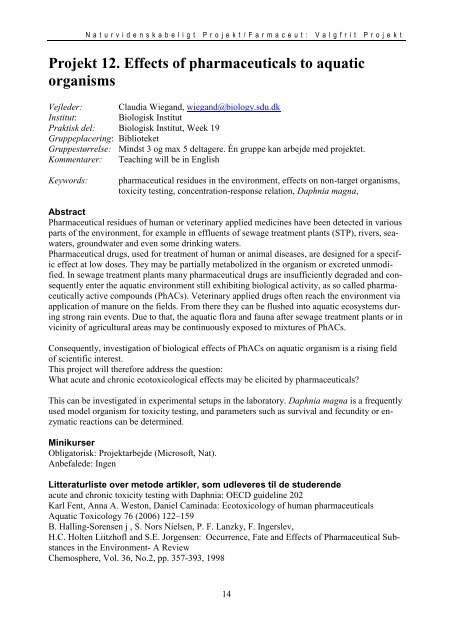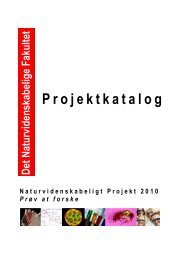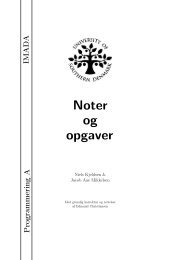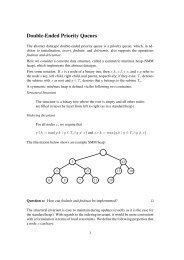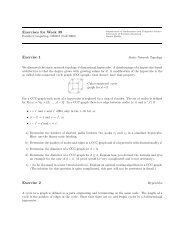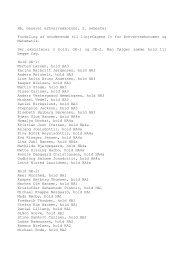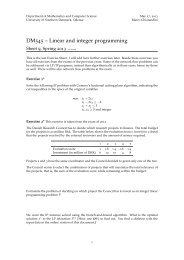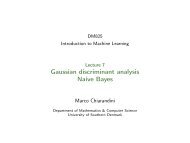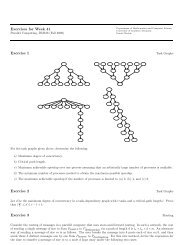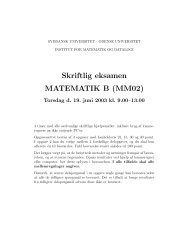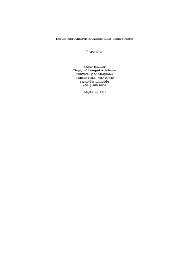Projekt 4. - Institut for Matematik og Datalogi - Syddansk Universitet
Projekt 4. - Institut for Matematik og Datalogi - Syddansk Universitet
Projekt 4. - Institut for Matematik og Datalogi - Syddansk Universitet
Create successful ePaper yourself
Turn your PDF publications into a flip-book with our unique Google optimized e-Paper software.
N a t u r v i d e n s k a b e l i g t P r o j e k t / F a r m a c e u t : V a l g f r i t P r o j e k t<br />
<strong>Projekt</strong> 12. Effects of pharmaceuticals to aquatic<br />
organisms<br />
Vejleder:<br />
<strong>Institut</strong>:<br />
Praktisk del: Biol<strong>og</strong>isk <strong>Institut</strong>, Week 19<br />
Gruppeplacering: Biblioteket<br />
Claudia Wiegand, wiegand@biol<strong>og</strong>y.sdu.dk<br />
Biol<strong>og</strong>isk <strong>Institut</strong><br />
Gruppestørrelse: Mindst 3 <strong>og</strong> max 5 deltagere. Én gruppe kan arbejde med projektet.<br />
Kommentarer: Teaching will be in English<br />
Keywords:<br />
pharmaceutical residues in the environment, effects on non-target organisms,<br />
toxicity testing, concentration-response relation, Daphnia magna,<br />
Abstract<br />
Pharmaceutical residues of human or veterinary applied medicines have been detected in various<br />
parts of the environment, <strong>for</strong> example in effluents of sewage treatment plants (STP), rivers, seawaters,<br />
groundwater and even some drinking waters.<br />
Pharmaceutical drugs, used <strong>for</strong> treatment of human or animal diseases, are designed <strong>for</strong> a specific<br />
effect at low doses. They may be partially metabolized in the organism or excreted unmodified.<br />
In sewage treatment plants many pharmaceutical drugs are insufficiently degraded and consequently<br />
enter the aquatic environment still exhibiting biol<strong>og</strong>ical activity, as so called pharmaceutically<br />
active compounds (PhACs). Veterinary applied drugs often reach the environment via<br />
application of manure on the fields. From there they can be flushed into aquatic ecosystems during<br />
strong rain events. Due to that, the aquatic flora and fauna after sewage treatment plants or in<br />
vicinity of agricultural areas may be continuously exposed to mixtures of PhACs.<br />
Consequently, investigation of biol<strong>og</strong>ical effects of PhACs on aquatic organism is a rising field<br />
of scientific interest.<br />
This project will there<strong>for</strong>e address the question:<br />
What acute and chronic ecotoxicol<strong>og</strong>ical effects may be elicited by pharmaceuticals?<br />
This can be investigated in experimental setups in the laboratory. Daphnia magna is a frequently<br />
used model organism <strong>for</strong> toxicity testing, and parameters such as survival and fecundity or enzymatic<br />
reactions can be determined.<br />
Minikurser<br />
Obligatorisk: <strong>Projekt</strong>arbejde (Microsoft, Nat).<br />
Anbefalede: Ingen<br />
Litteraturliste over metode artikler, som udleveres til de studerende<br />
acute and chronic toxicity testing with Daphnia: OECD guideline 202<br />
Karl Fent, Anna A. Weston, Daniel Caminada: Ecotoxicol<strong>og</strong>y of human pharmaceuticals<br />
Aquatic Toxicol<strong>og</strong>y 76 (2006) 122–159<br />
B. Halling-Sorensen j , S. Nors Nielsen, P. F. Lanzky, F. Ingerslev,<br />
H.C. Holten Liitzhofl and S.E. Jorgensen: Occurrence, Fate and Effects of Pharmaceutical Substances<br />
in the Environment- A Review<br />
Chemosphere, Vol. 36, No.2, pp. 357-393, 1998<br />
14


